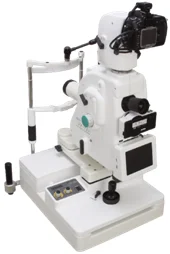FUNDUS FLUROSCEIN ANGIOGRAPHY

Fundus fluorescein angiography is a common procedure that is performed to evaluate back surface of patient’s eye. A small amount of yellow fluorescein dye will be injected into a vein in patient’s arm. The dye travels to eye where it highlights the blood vessels.
It help to diagnose eye disorders, such as macular degeneration or diabetic retinopathy.
Macular Degeneration occurs in the macula, which is the part of the eye that allows you to focus on fine detail. Sometimes, the disorder worsens so slowly that you may not notice any change at all. In some people, it causes vision to deteriorate rapidly and blindness in both eyes may occur.
Because the disease destroys your focused, central vision, it prevents you from
- Seeing objects clearly
- Driving
- Reading
- Watching television
Diabetic Retinopathy: is caused by long-term diabetes and results in permanent damage to the blood vessels in the back of the eye, or the retina. The retina converts images and light that enter the eye into signals, which are then transmitted to the brain through the optic nerve.
There are two types of this disorder :
- Non-proliferative diabetic retinopathy, which occurs in the initial stages of the disease
- Proliferative diabetic retinopathy, which develops later and is more severe
The Fundus Fluorescein angiography is determine, if treatments for these eye disorders are working.
Normal Results: If eyes are healthy, the blood vessels will have normal shape and size. There will be no blockages or leaks in the vessels.
Abnormal Results: Abnormal results will reveal a leak or blockage in the blood vessels. This may be due to
- A circulatory problem
- Cancer
- Diabetic Retinopathy
- Macular Degeneration
- High Blood Pressure
- A Tumor
- Enlarged Capillaries In The Retina
- Swelling Of The Optic Disc